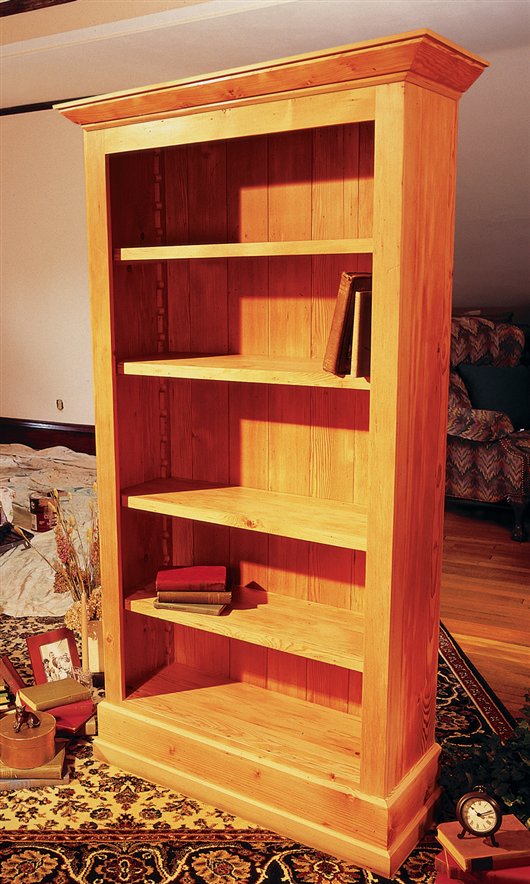We may receive a commission when you use our affiliate links. However, this does not impact our recommendations.

Cottage Bookcase
Reclaimed
Douglas fir
gives rustic
charm.
By David Radtke
Every board of this bookcase is full of character—nail
holes, gouges and even hammer marks. That’s because
each piece was pulled from an old Montgomery Ward
warehouse in Baltimore.
Originally part of a large shelving system built more than 75
years ago, our reclaimed boards still retained a dusty aroma and had
mellowed to a rich warm color. These unique characteristics influenced
the design of our bookcase—straightforward and reminiscent
of rustic folk furniture. The bookcase is constructed from 3/4″
boards. Unlike most plywood-backed bookcases, the back of this
bookcase is assembled from individual pieces splined together.
To build this piece you’ll need a tablesaw, a jointer, a router
and a biscuit joiner—although you could use a doweling jig.
A large assembly table or a make-shift work surface made
from a 3/4″ plywood sheet laid over sawhorses is a must.
Figure on spending about three days in your shop to complete
this piece. |
|

You may also like…
Sliding Door Bookcase
Dovetailed Bookcase
Stickley Bookcase
Two-Part Bookcase
Bow-Front Bookcase
Mission Bookstand
Grand Walnut Bookcase
Contemporary Bookcase |
Cut 3/8″ deep rabbets and dadoes into the side panels
to accept the solid wood back pieces as well as the top and
bottom panels. Use a featherboard to keep the panel tight to
the fence to ensure an even edge on the rabbets. The bottom
horizontal panel should fit snugly into the dado, so adjust your
dado blade precisely or make multiple passes. |
|
Click any image to view a larger version.

|
Bore evenly spaced 1″ holes for the shelf supports. Mount
a board onto the table of your drill press and attach a fence to
it for exact centering of each hole. Once the holes are drilled,
cut each piece to length, then rip it down the middle to make a
matched pair for each side. Glue and clamp each pair to the
inside edge of each side panel. |
|
 |
Screw the top into the upper dadoes of the sides and glue
and clamp the bottom into the lower dadoes. Measure the
diagonals. They must be equal to square the case. Once the glue
is dry, flip the case face down. Make sure the case is square and
screw blocks along the sides and top into the work surface to
keep it square as you install the back panels. |
|
 |
Rip, then joint the edges
of all the back pieces. Rout
a 1/4″ groove
into the center of each
side edge.
Glue a
slightly
thinner
than 1/4″
by 11/16″
pine spline
into one side
of each back
piece. Once
the glue has
dried, fit each back
piece to the back of the
case. Start in the center and
work your way to the sides. |
|
 |
Glue the face
frame to the front
edges of the case. Be
sure it’s perfectly
aligned, then clamp it
to the case every foot
along the perimeter.
Trim the slight overhang
on each side
with a block plane
once the glue is dry. |
|
 |
Shape the cornice moldings on
the tablesaw. Set the blade at 45°. Run
each board through on both faces to
create bevel edges, then repeat for the
other edge. The other narrow cornice
molding is a simple 45°piece cut from a
1-3/4″ piece of 3/4″ stock. |
|
 |
Fit the center cornice molding
(N) to the upper cornice molding and to the lower cornice molding. |
|
 |
Product Recommendations
Here are some supplies and tools we find essential in our everyday work around the shop. We may receive a commission from sales referred by our links; however, we have carefully selected these products for their usefulness and quality.
















